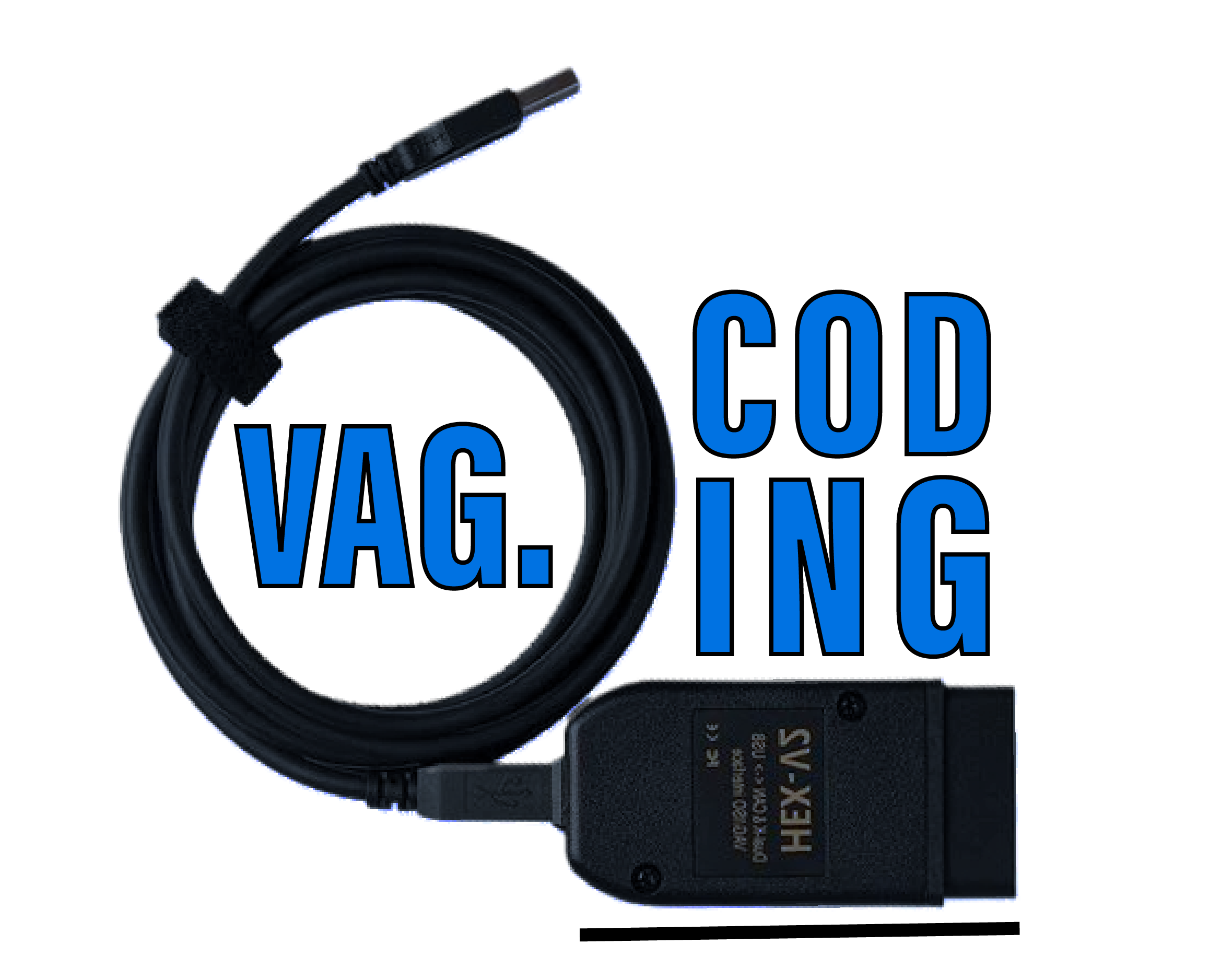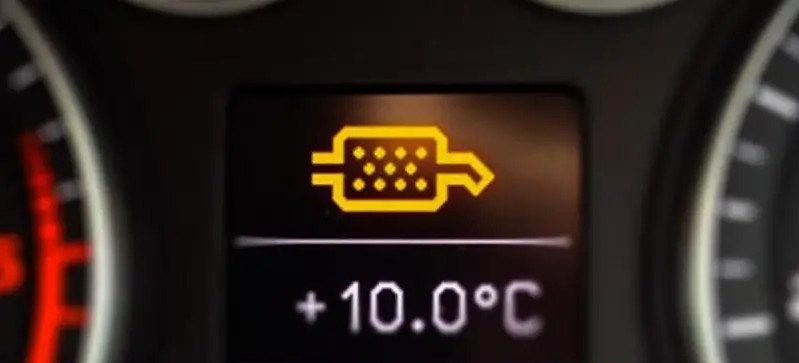
The Diesel Particulate Filter (DPF) reduces pollutant gas emissions. It operates in two stages.
- Filtration: this retains the most polluting particles. In the process, a layer of soot forms on the filter, which can prevent air from passing through the mechanism. This is why the FAP then moves on to the second stage
- Regeneration: the system automatically burns off this layer of soot, without any action on the part of the driver.
However, to regenerate, the FAP needs a very high temperature, between 550 and 650 degrees, i.e. with an engine running at around 3,000 rpm. However, if you use your car in town or for short journeys, it’s very rare for your engine speed to be that high. The risk is that the DPFS could become clogged, damaging the engine and the entire system.
Since more and more short trips clog up the particulate filter, the most effective solution is actually to take to the road. It is possible to clean a DPF while driving. For a good cleaning, you need to increase your car’s engine speed to at least 3,000 rpm over a few dozen kilometers, as you drive on the freeway, for example. As engine speed rises, so does engine temperature, allowing soot to be burned off and the DPFS to be cleaned.
There’s no need to change the oil after a DPF regeneration.
-> VCDS : Turbo pressure control
-> VCDS: Debrider maximum speed (V-max)
-> VCDS: Checking injector values
Contents:
- Regeneration for 1.6 and 2.0 CR TDI (Golf 6/7, Audi A3 8V…)
- Regeneration for 3.0 TDI (Audi A4 B8/A5 8T/Q5/Q7…)
- Regeneration for 1.4-1.9-2.0 R4 & 2.5 R5 TDI (Golf 5/6, Audi A3 8P…)
To force the regeneration of the particulate filter, VAG Coding offers three tutorials depending on your TDI diesel engine.
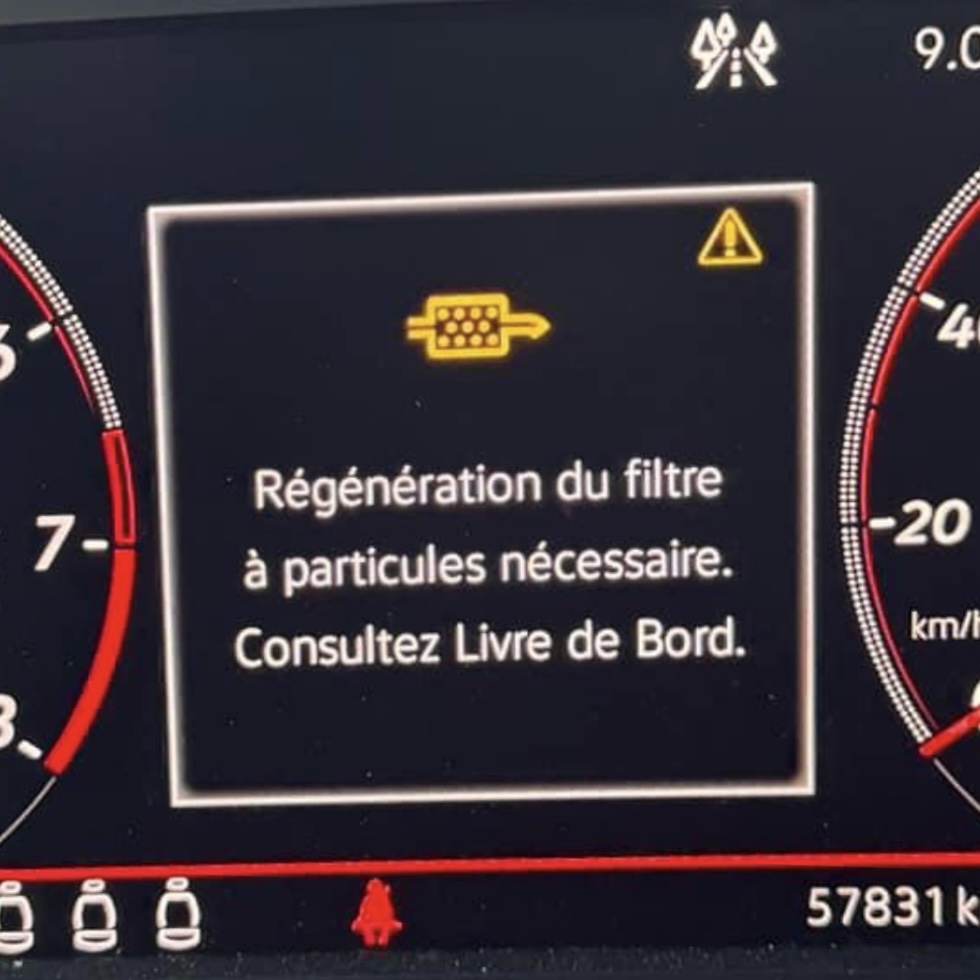
Forced regeneration of DPFS at standstill for 1.6 and 2.0 CR TDI :
The CR-TDI engine offers two different particulate filter (DPF) regeneration modes, depending on its load (rate of clogging or fouling).
If the measured load reaches 30gr but does not exceed 40gr, DPF regeneration is possible at standstill.
It is also possible to run a forced regeneration while driving, when, for example, the FAP load is greater than 40gr (but less than 45gr).
Above 45gr , the FAP is considered clogged, and replacement or removal of the particulate filter (FAP) should be considered.
General prerequisites :
- No fault stored in ECU
- Key in contact
- Engine on
- Fuel tank at least 1/4 full
- Neutral/parking transmission
- Handbrake engaged
- Temperature above 70°C
(seemeasurement group 002.4) - FAP load below manufacturer’s specification
- (see measurement group 075.3, VCDS should indicate this value)
- Current consumers activated
(Lights, heating, heated seats, defrosting…) - Engine hood closed
[Select]
[01 – Motor]
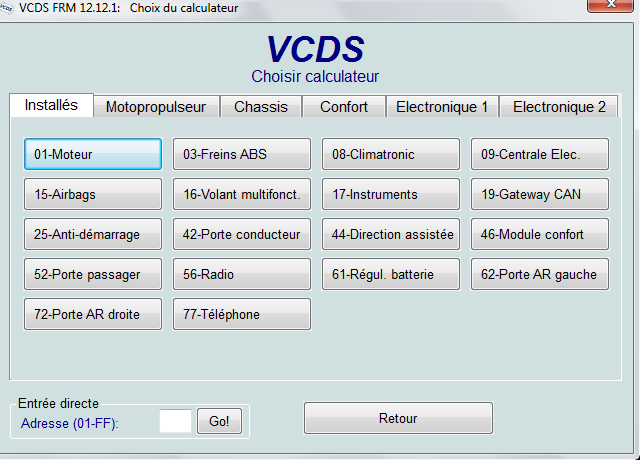
[Secure access – 16]
- Enter the code displayed by VCDS to activate forced regeneration at standstill (27971)
[Go!]
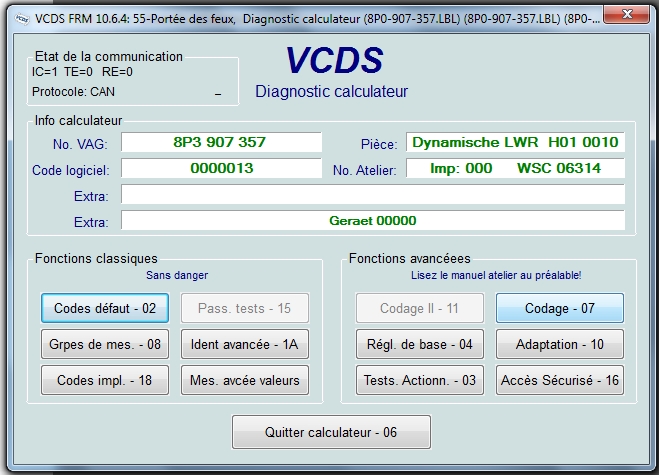
[Basic settings – 04]
- Select the corresponding block to activate forced regeneration at standstill (Particle filter maintenance regeneration)
[Go!]
[On/Off/Next] if the default setting is not ON
- Follow the instructions on the display.
The FAP regeneration procedure takes approximately 30 minutes. - the particle filter warning light appears on the ODB, engine speed rises to 1500 rpm.
[End, Back]

Check the following groups after FAP regeneration
Particle filter charge should be as close as possible to 0%.
Exhaust gas temperature 1 bench 1 –> To check that the temperature is rising. It should reach around 500°.
Calculated soot mass –> this value should be lower after regeneration
[Measurement block – 08]
Select blocks 099 and 108
[Go!]
- Measurement group 099.2: Exhaust gas temperature before turbocharging
- Measurement group 099.3: Exhaust gas temperature before FAP
- Measurement group 099.4: Exhaust gas temperature after FAP
- Measurement group 108.2: FAP clogging rate (calculated)
If this group is empty, use group 241.2. - Measurement group 108.3: FAP clogging rate (measured)
If this group is empty, use group 241.3.
[End, return]
Forced regeneration of DPFS at standstill for 3.0 TDI :
Particle filter emergency regeneration e.g. ASB (233hp) / BKN (204hp)
Prerequisites:
- Contact: ON
- Engine: on the move
- Engine oil temperature 70°C (see MVB 007.2)
- FAP soot load under 68g (see MVB 104.3)
- If the FAP charge exceeds 68g, you need to change the filter because it can burn during regeneration (Audi recommends this, so try at your own risk): )
- Engine hood: closed
- Hand brake: activated
- Transmission on (P)ARK
- Exhaust temperatures can reach 300°C!!!
- No fault code
- Options that consume energy when running (headlights, air conditioning, heated seats, defrost)
Regeneration can take up to 40 minutes, with the motor automatically running at 1500 rpm.
[select]
[01 – Engine]
[Coding-II – 11]
- Start regeneration by typing 10016.
[Do It!]
[Meas. Blocks – 08]
Select these 3 groups 100, 101 and 102
[Go!]
MVB 100.1: Engine speed
MVB 100.3: Regeneration Counter
MVB 100.4: Regeneration stop (0 = no stop / 1 = stop performed)
MVB 101.4: Regeneration Status (001 = temperature increase, 010 =regeneration, 100 = cooling)
MVB 102.1: Temperature before catalytic converter
MVB 102.2: Temperature before DPF
[Done, Go Back]
[Close Controller, Go Back – 06]
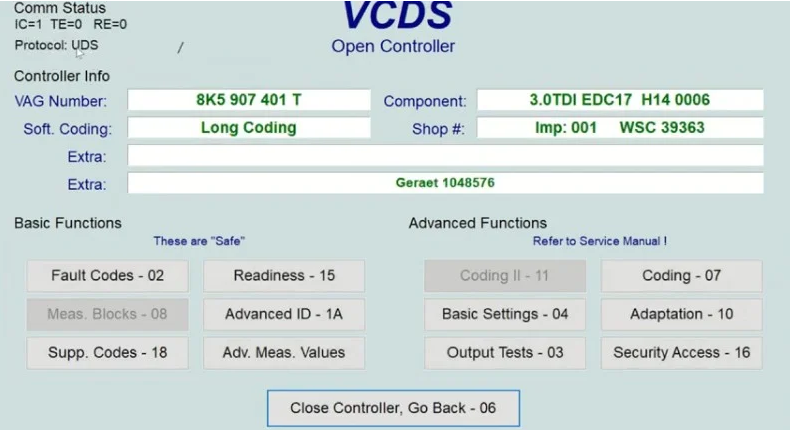
Forced regeneration of DPFS while driving for 1.4-1.9-2.0 R4 & 2.5 R5 PD/PPD TDI
General prerequisites :
- No fault stored in ECU
- Key in contact
- Engine on
- Temperature above 50°C
(see measurement group 002.4) - FAP load below manufacturer’s specification
(see measurement group 075.3, VCDS should indicate this value)- If the FAP load exceeds the manufacturer’s specification, the FAP cannot be regenerated.
It will have to be replaced or removed as there is a significant risk of fire.
- If the FAP load exceeds the manufacturer’s specification, the FAP cannot be regenerated.
- Current consumers activated
(Lights, heating, heated seats, defrosting…)
Forced regeneration of DPFS while driving :
- Vehicle speed between 30 and 60 km/h
- Engine speed between 1500 and 2500 rpm
(4th or 5th gear – automatic transmission on Tiptronic) - Total duration is about 15-20 min.
- Exhaust gas temperature before turbo above 700°.
[Select]
[01 – Motor]
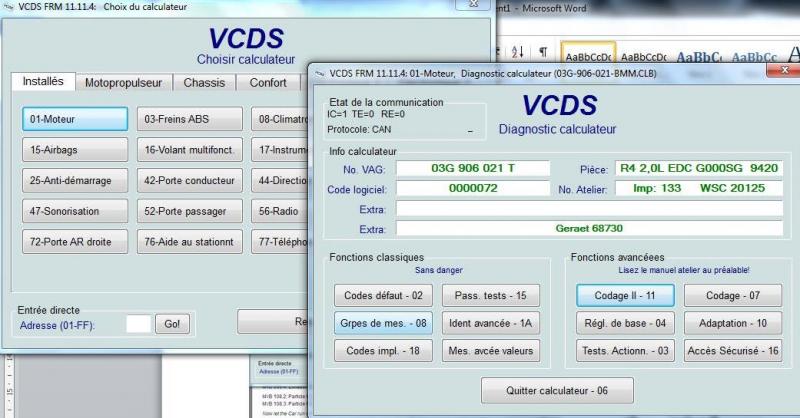
[Coding-II – 11]
- Activate regeneration by entering code 21295
[Go!]
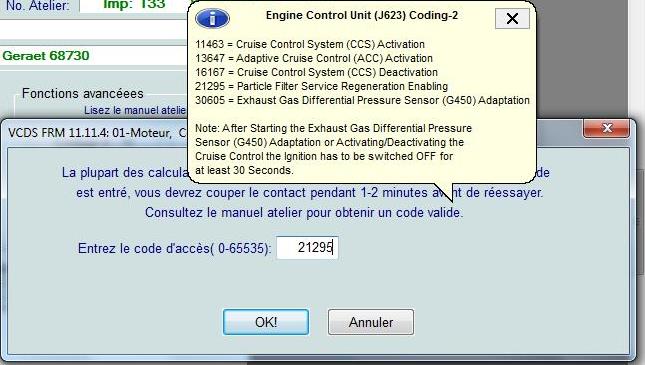
The particle filter indicator appears on the ODB.
[Measurement group – 08]
Select groups 070 and 075
[Go!]
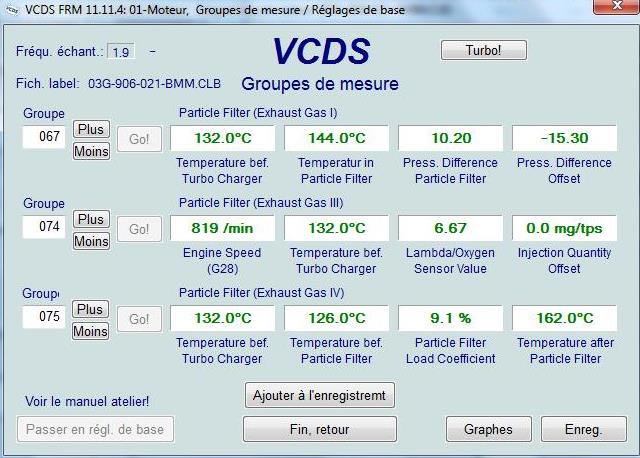
- Measurement group 070.1: FAP regeneration status
xxxxxxx1= normal regeneration in progress
xxxxxx1x= forced regeneration in progress - Measurement group 070.3: Regeneration counter/timer
- Measurement group 075.1: Exhaust gas temperature before turbocharging
- Measurement group 075.2: Exhaust gas temperature after turbocharger
- Measurement group 075.3: Particulate filter (FAP) charge
- Measurement group 075.4: Exhaust gas temperature after FAP
Start the driving cycle by monitoring the measurement blocks
To do this, drive for 15-20 minutes at 2500-3000 rpm, on a freeway or expressway for example.
Drive the vehicle under the conditions specified above until the particulate filter (DPF) charge is as low as possible (close to 0%).
These sensors will enable us to check the temperatures of various components.
Sensor 075.3 “Particle Filter Load Coefficient” is set here at 9.1%; when it reaches 0%, regeneration is complete.
[End, Back]

The FAP light on the dashboard disappears after a few minutes.
